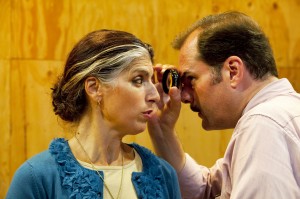Collaboration or Imposition:
Can Directing Rewrite a Script?
On a stage floor and backdrop of unfinished plywood populated by a woman, a man, two chairs, a pen light, an eye patch, a cymbal and furniture leg, and a baby grand piano, Vision Disturbance tells the story of an unlikely relationship between an ophthalmologist and his patient.
In her newest play, Christina Masciotti mines her own childhood experiences to create two characters from disparate worlds who share a knack for bending language to better suit their needs. The patient, Mondo (short for Diamondo), brings her world into the examining room where she presses Dr. Hull for a quick cure for her malady, diagnosed by him as Idiopathic (cause unknown) Central Serous Chorioretinopathy, a blurring of vision in one eye that he attributes to stress. While he prescribes and treats her with music to help her relax, she shares with him and the audience the ongoing drama of divorce proceedings she recently initiated against her philandering husband.
Directed by Richard Maxwell and produced by the New York City Players, Vision Disturbance relies heavily on dialogue between the two characters and monologues directed at the audience. Mondo, an emigre from Greece, effectively fractures English idioms to enhance their communicative power. Dr. Hull’s utterances, mostly devoid of emotion except when punctuated by chilling expressions of rage, say more than he can imagine.
Describing her situation, Mondo explains that she’s “between a rock and hell.” About her husband of 13 years, she says he’s “the scum of the dirt.” Dr. Hull, living upstairs from his mother, tells Mondo about his old cat, Socks, who enjoys being pulled up by his tail as he clutches the carpet with his claws. The doctor, yet to master the intricacies of his smart phone, promises Mondo he’ll call a lawyer friend for her “if I can work this; I keep taking pictures of my ear.” He deals with the lawyer’s refusal by cursing at him and later, when the phone rings, hurls it across the stage, explaining that he still hasn’t figured out how to turn it off.
When Dr. Hull prescribes music as a de-stressor for his patient, initially he has in mind its soothing power. But for Mondo, it’s most effective as an outlet for her anger not just at her husband’s betrayal, but also at the traditional Greek culture that provides men with that kind of freedom while constraining women to serve them. In one of their sessions, when her doctor gives her the furniture leg to use on the cymbal, she goes at it with verve, filling the theater with loud, unnerving reverberations. Later she’ll find great relief in the percussive power of the piano, which will fall apart under her pounding.
As more comes to light about Dr. Hull’s own affliction–back pain diagnosed as arthritis for which he takes lots of pain pills–and the narrowness of his life, one wonders whether he wouldn’t benefit from some of his own music therapy. The patient with visual problems displays the clarity that the doctor lacks. The wounded woman finds her way at the same time the man in authority loses his.
Masciotti’s script provides the perfect vehicle for Maxwell’s direction, known for its reductionism. Stripping it bare of stage directions that include a doctor’s office, a front door that Mondo opens to find a box with the eye patch she ordered (in the production, she retrieves the box from the top of the piano) and head gear for a special eye examination, Maxwell substantially changes the visual aspects of the play. The character of the actors’ speech probably owes more to Maxwell’s inclination to drain tone from speech and focus attention on content than to Masciotti’s original vision for the play.
Maxwell’s directing style works well here; his simplifications spotlight Masciotti’s skillful dialogue and take advantage of her indifference to stage directing. But when a seasoned playwright and director like Maxwell picks up a script of a writer whose day job is teaching college math, the situation has the potential to devolve into the same power struggle between the sexes portrayed in Mondo’s narration about her marriage and subsequent divorce proceedings.
Vision Disturbance demonstrates in its content as well as its style the transformative power of relationships. The play’s coda, anchored in Masciotti’s original ideas for the staging, will surprise and delight the audience, revealing a musical setting that supports the characters as they grapple with the uncertainty of newly altered roles.
Vision Disturbance
Abrons Arts Center
Henry Street Settlement
466 Grand Street
New York, NY 10002
(212)598-8329


